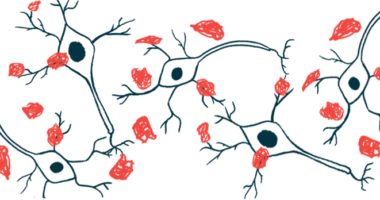Rare TTR Gene Mutation Detected in Three Japanese Patients With FAP

Familial amyloid polyneuropathy (FAP) caused by Thr49Ser, a rare disease-causing mutation, was identified for the first time in three patients from Japan, as described in a recent case series.
The mutation appears to be highly penetrant, according to the report, meaning most people carrying it develop overt disease symptoms. All patients described in the study had nerve impairment and heart problems.
Altogether, these findings highlight the importance of early diagnosis and genetic counseling to improve outcomes for FAP patients.
The report, “Three patients of transthyretin amyloidosis in a Japanese family with amyloidogenic transthyretin Thr49Ser (p.Thr69Ser) variant,” was published in the European Journal of Medical Genetics.
Amyloid transthyretin (ATTR) amyloidosis is an umbrella term for disorders wherein abnormal protein deposits, called amyloid fibrils, accumulate in several tissues and organs, causing damage.
FAP is a hereditary form of ATTR amyloidosis in which amyloid deposits accumulate mainly in peripheral nerves — outside the brain and spinal cord — causing nerve damage.
The most common cause of FAP is a specific mutation in the TTR gene, called Val30Met. However, more than 150 harmful mutations or deletions in this gene have been identified thus far. Different mutations affect different organs and cause distinct clinical manifestations.
Very little is known about the Thr49Ser mutation, as it is rarely reported. Researchers said the lack of information about it could be a barrier to providing genetic counseling.
Three Japanese patients with FAP caused by the Thr49Ser variant were identified, and researchers have described their symptoms and analyzed this rare mutation’s penetrance.
“This is the first report of east Asian patients with hereditary TTR amyloidosis due to the pathogenic [disease-causing] Thr49Ser variant,” the researchers wrote.
The first patient was a 68-year-old woman with a history of carpal tunnel syndrome, a common FAP symptom characterized by pain, numbness, and tingling in the hands and arms.
She also had congestive heart failure, a condition in which the heart is no longer able to efficiently pump blood throughout the body, and orthostatic hypotension, which causes blood pressure to suddenly drop when standing up from sitting or lying down. Her mother and sister were both diagnosed with ATTR amyloidosis and died of heart failure.
A biopsy of the heart muscle was taken and stained with a dye called Congo red, which marks amyloid deposits. This test, along with others, revealed TTR amyloid fibrils were present in heart tissues. A genetic analysis also confirmed the Thr49Ser mutation.
The second patient was a 45-year-old woman and the niece of the first patient. She had similar heart issues, orthostatic hypotension, and shortness of breath during exercise. She reported having abnormal sensations in both legs and around the navel at the age of 40.
TTR amyloid fibrils were found in her heart and the density of intra-epidermal nerves was reduced in a skin biopsy from her calf. Gene sequencing detected the Thr49Ser variant.
The last patient was a 42-year-old man. He was the nephew of the first patient and the brother of the second. He had numbness in the median nerve area of both hands, suggestive of carpal tunnel syndrome, and reported decreased temperature sensation below both knees when he was 38. The median nerve is a large nerve that runs from the base of the neck to the hand and is responsible for providing sensation to all fingers, apart from the little finger.
He had no heart symptoms, but a biopsy of abdominal wall fat pad tissue revealed TTR amyloid deposits. Genetic tests confirmed he also carried the Thr49Ser variant.
Analysis of the family pedigree, which shows the relationship between members and the inheritance of a trait or disease though several generations, suggested the Thr49Ser variant was highly penetrant.
“This finding has a significant clinical implication,” the authors wrote. “Although our patients … showed the cardiac manifestation of this gene variant around their 40’s, the high penetrance of this variant indicates that physicians can diagnose the presence of this variant through genetic counseling well before the appearance of symptoms.”
While the first and second patient were treated with Onpattro (patisiran), an approved FAP therapy marketed by Alnylam Pharmaceuticals, the third patient received Vyndaqel (tafamidis), an approved medication developed by Pfizer for treating heart disease in patients with ATTR amyloidosis.
“The present three patients with Thr49Ser variant showed variation in [symptoms] including cardiac and neurological manifestations at a fairly young age. In addition, the familial relationship in this report suggested that this variant is highly penetrant,” the authors wrote.
“Early genetic diagnosis due to collecting the genetic information from family medical history may be beneficial to improve patient prognosis via early therapeutic intervention,” they wrote.







